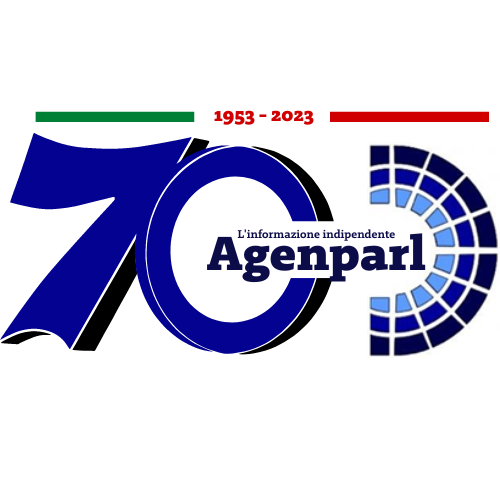 (AGENPARL) - Roma, 1 Agosto 2025
(AGENPARL) - Roma, 1 Agosto 2025(AGENPARL) – Fri 01 August 2025 A weekly compendium of media reports on science and technology achievements
at Lawrence Livermore National Laboratory. Though the Laboratory reviews
items for overall accuracy, the reporting organizations are responsible for
the content in the links below.
LLNL Report, Aug. 1, 2025
The National Ignition Facility’s preamplifier module increases the laser
energy as it travels to the target chamber. (Image: Damien Jemison)
A peek inside NIF
https://www.economist.com/interactive/2025/07/23/inside-the-top-secret-labs-that-build-americas-nuclear-weapons
Each experiment at the National Ignition Facility (NIF) in California — a
“shot” — lasts just a few billionths of a second. A lot happens in that
brief moment, however: 192 laser beams, totaling some 500trn watts, converge
in the machine’s target chamber and dump their energy onto a gold cylinder,
which is just a few centimeters long. Inside the cylinder is a
peppercorn-size diamond sphere filled with a mixture of deuterium and
tritium, heavy isotopes of hydrogen.
As the sphere absorbs the laser’s energy, its outer layers rapidly ablate
away. That creates a shock wave travelling at 300km per second that implodes
the sphere’s insides. As the atoms of deuterium and tritium are pushed
together at billions of times atmospheric pressure, their temperatures
exceeding 100m°C, they start fusing into helium, releasing vast amounts of
energy.
This is the kit you need to be able to re-create a nuclear-weapon explosion
without actually setting off a bomb.
Read More
https://www..economist.com/interactive/2025/07/23/inside-the-top-secret-labs-that-build-americas-nuclear-weapons
A rendering of Firefly’s Elytra Dawn vehicle utilizing LLNL’s telescope
to perform space domain awareness operations. (Graphic credit: Firefly
Aerospace)
LLNL optics will go into orbit
In this week’s R&D roundup, Lawrence Livermore National Laboratory lands a
deal to construct a cutting-edge telescope for space surveillance.
The story: Lawrence Livermore National Laboratory has been selected by the
Department of Defense’s Defense Innovation Unit to build a new monolithic
telescope for a mission launching as early as 2027. The telescope will be
operated onboard Firefly Aerospace’s Elytra orbital vehicle for a mission
in low Earth orbit.
The numbers: The telescope will have a diameter of 10 inches (25 cm). LLNL
will build the telescope and deliver it flight-ready in 13 months. This will
be LLNL’s third mission to develop space payloads for the Defense
Department.
Why it matters: The mission will include space domain awareness operations,
which are needed for national security and identifying factors that could
interfere with future space missions.
Read More
The 3D quantum ghost imaging microscope setup. (Credit: Eshun et al.)
Ghost imaging: a spooky science
https://phys.org/news/2025-07-microscope-3d-ghost-images-nanoparticles.html
Ghost imaging is like a game of Battleship. Instead of seeing an object
directly, scientists use entangled photons to remove the background and
reveal its silhouette. This method can be used to study microscopic
environments without much light, which is helpful for avoiding photodamage to
biological samples.
So far, quantum ghost imaging has been limited to two dimensions, or to two
planes at fixed z positions. In a new study, published in Optica, scientists
at Lawrence Livermore National Laboratory (LLNL) developed a 3D quantum ghost
imaging microscope — the first of its kind.
“This is a new way of 3D imaging that can do things with more sensitivity and
gather more information without having to scan a sample,” said LLNL scientist
and author Audrey Eshun.
The method works based on the quantum phenomenon of entanglement. In
comparison to other techniques, 3D quantum ghost imaging doesn’t require
scanning the sample — it can happen all at once.
Read More
https://phys.org/news/2025-07-microscope-3d-ghost-images-nanoparticles.html
/The DeNOVO project will apply high-performance computing and AI to push the
boundaries of antibody design. (Graphic: Dan Herchek/LLNL)/
Applying AI to antibodies
In a pioneering project aimed at advancing the design of antibodies and
antibody-like molecules through the power of AI, Lawrence Livermore National
Laboratory (LLNL) is working to transform medical countermeasure development
and biologics discovery. The project is part of an interagency agreement
between the Advanced Research Projects Agency for Health and the Department
of Energy.
Under the three-year DeNOVO project, LLNL and other institutions will apply
high-performance computing and AI to push the boundaries of antibody design.
These efforts could overcome significant challenges in antibody design,
including the sparseness of publicly available datasets and the substantial
computing resources required for model training. DeNOVO will develop
experimental methods for ultra-high-throughput antibody characterization to
enable computational prediction and, ultimately, generative design of
antibody-antigen interactions.
“AI-based design of antibody-based medicines will revolutionize drug
discovery and dramatically accelerate our responsiveness to pandemic
pathogens and other biothreats,” said Matthew Jemielita, who leads the
DeNOVO initiative at LLNL.
Read More
Nate Gleason testifies before the Subcommittee on Cybersecurity and
Infrastructure Protection on July 22. (Photo: Committee on Homeland Security)
Layers of infrastructure protection
https://industrialcyber.co/industrial-cyber-attacks/us-critical-infrastructure-remains-exposed-as-congress-confronts-ot-cybersecurity-gaps-fifteen-years-after-stuxnet/
Fifteen years after the discovery of Stuxnet revealed the destructive
potential of cyberattacks on industrial control systems, the U.S. is still
woefully unprepared for a concerted cyberattack on its critical
infrastructure. OT (operational technology) networks, which include those
that run power grids, water treatment plants, and other critical
infrastructure, are still insufficiently protected, cybersecurity experts
said at a congressional hearing this week..
“Today, we are dealing with highly capable adversaries who bring a wide
spectrum of capabilities to bear, including network operations, supply chain
compromise, insider access and close-access operations,” Nate Gleason,
program leader for the cyber and infrastructure resilience program at
Lawrence Livermore National Laboratory, wrote in his testimony.
Detection and mitigation are only one part of defending critical
infrastructure from nation-state cyber threats, Gleason said. At LLNL, the
challenge is addressed through a layered framework designed to frustrate
adversaries’ objectives and ensure critical infrastructure can continue
operating even under attack.
Read More
https://industrialcyber.co/industrial-cyber-attacks/us-critical-infrastructure-remains-exposed-as-congress-confronts-ot-cybersecurity-gaps-fifteen-years-after-stuxnet/
——————————————————————————
Founded in 1952, Lawrence Livermore National Laboratory https://www.llnl.gov
provides solutions to our nation’s most important national security
challenges through innovative science, engineering and technology. Lawrence
Livermore National Laboratory is managed by Lawrence Livermore National
Security, LLC for the U.S. Department of Energy’s National Nuclear Security
Administration.
Read previous Lab Report articles online https://www.llnl.gov/news/lab-report
Unsubscribe from this newsletter
